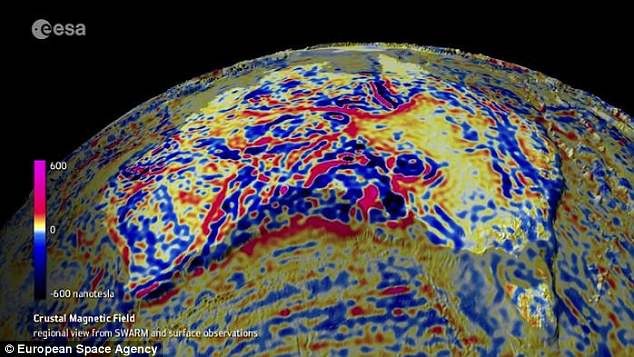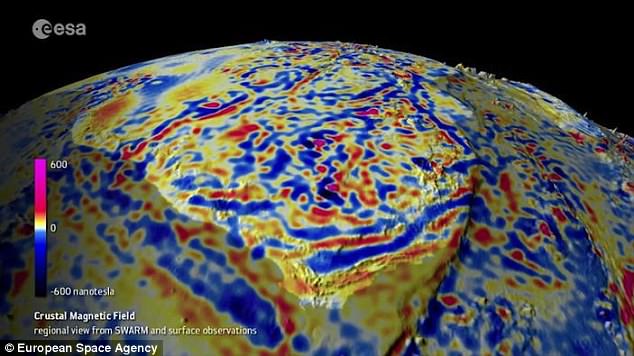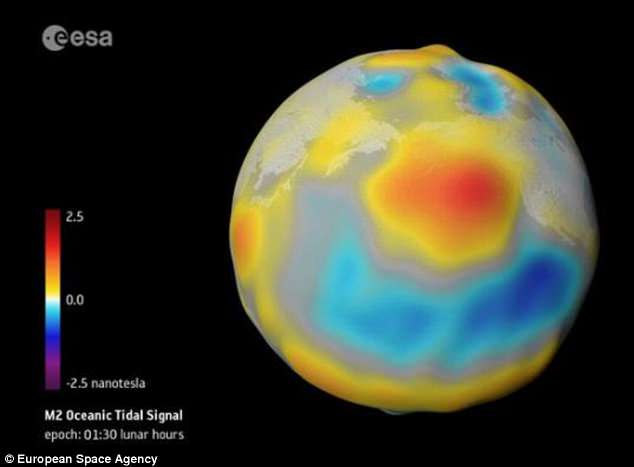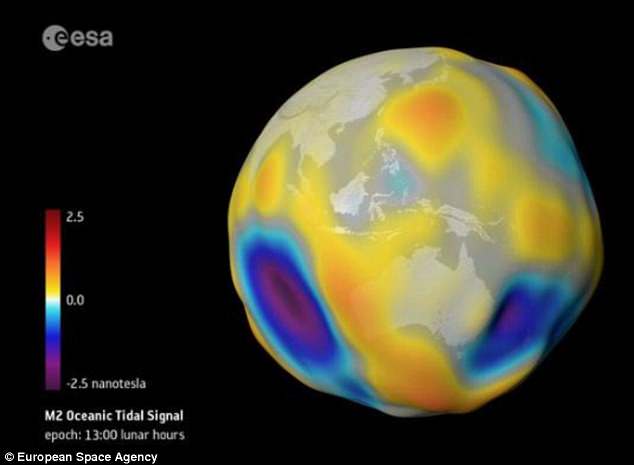Earth's Second Magnetic Field: Mysterious 'Cocoon' That Protects Our Planet From Solar Storms Is Mapped From Space In Stunning New Detail
by Harry Pettit; Mailonline
New Esa movie shows thousands of tiny fluctuations in Earth's magnetic signals
The European Space Agency used three satellites to build the digital map
It is the most detailed ever rendering of the signals created by the lithosphere
The map is being used to understand more about Earth's geological history
Earth's magnetic field has been mapped from space in stunning new detail.
A new movie shows thousands of tiny fluctuations in Earth's magnetic signals created by ocean tides and our planet's rigid outer layer, known as its 'lithosphere'.

The European Space Agency used three satellites to build the map, which it says is the most detailed ever rendering of magnetic fluctuations across Earth's crust.
The magnetic field is a layer of charge that surrounds our planet and deflects charged particles fired from the sun known as 'solar wind'.
Without this protective layer, these particles would likely strip away the Ozone layer, our only line of defence against harmful UV radiation.
The map, which is being used to understand more about Earth's geological history, is thanks to four years of measurements from the agency's Swarm satellites.
Imagery from the spacecraft was combined with historical data from a previous German spacecraft called Champ and observations from ships and aircraft.
Project scientist Dr Erwan Thebault from the University of Nantes in France said: 'This is the highest resolution model of the lithospheric magnetic field ever produced.
'With a scale of 250 kilometres [155 miles], we can see structures in the crust like never before.
'And, we have gained even finer detail in some parts of the crust, such as beneath Australia, where measurements from aircraft have mapped at resolution of 50 km [30 miles].
'This combined use of satellite and near-surface measurements gives us a new understanding of the crust beneath our feet, and will be of enormous value to science.'



'It's a really tiny magnetic field. It's about 2-2.5 nanotesla at satellite altitude, which is about 20,000 times weaker than the Earth's global magnetic field,' Professor Nils Olsen, from the Technical University of Denmark, told BBC News.
Professor Olsen was speaking at the European Geosciences Union General Assembly (EGU) in Vienna, Austria, where a batch of new Swarm results have been released.


Each of the three identical satellites is loaded with sensors that constantly measure the magnetic field's strength, magnitude and direction.
Most of Earth's magnetic field is generated deep within the outer core by an ocean of superheated molten iron.
But other components also contribute to the overall signal, such as that coming from the oceans.

A small fraction of the magnetic field comes from magnetised rocks in the upper lithosphere, which includes Earth's rigid crust and upper mantle.
This lithospheric magnetic field is very weak and therefore difficult to detect from space.
As new ocean crust is created through erupting underwater volcanoes, iron-rich minerals are fired out in the upwelling magma.
These minerals are oriented to magnetic north at the time of eruption and solidified as the magma cools.

Since magnetic poles flip back and forth over time, this solidified magma forms alternating 'stripes' on the seafloor, providing a record of Earth's magnetic history.
These magnetic imprints on the ocean floor can be used as a sort of time machine, allowing past field changes to be reconstructed and showing the movement of tectonic plates from hundreds of million years ago until the present day.
'Magnetic fields are one of the keys to understand the sub-surface of the planet, in combination with other pieces of information such as gravity and seismic measurements,' said Dr Rune Floberghagen, Esa's Swarm mission manager.
'In the end this will allow us to determine the best ever model of the upper layers of the planet. This is the very clear, sworn ambition of the Swarm mission.'
Thanks to: https://www.riseearth.com
by Harry Pettit; Mailonline
New Esa movie shows thousands of tiny fluctuations in Earth's magnetic signals
The European Space Agency used three satellites to build the digital map
It is the most detailed ever rendering of the signals created by the lithosphere
The map is being used to understand more about Earth's geological history
Earth's magnetic field has been mapped from space in stunning new detail.
A new movie shows thousands of tiny fluctuations in Earth's magnetic signals created by ocean tides and our planet's rigid outer layer, known as its 'lithosphere'.

The European Space Agency used three satellites to build the map, which it says is the most detailed ever rendering of magnetic fluctuations across Earth's crust.
The magnetic field is a layer of charge that surrounds our planet and deflects charged particles fired from the sun known as 'solar wind'.
Without this protective layer, these particles would likely strip away the Ozone layer, our only line of defence against harmful UV radiation.
The map, which is being used to understand more about Earth's geological history, is thanks to four years of measurements from the agency's Swarm satellites.
Imagery from the spacecraft was combined with historical data from a previous German spacecraft called Champ and observations from ships and aircraft.
Project scientist Dr Erwan Thebault from the University of Nantes in France said: 'This is the highest resolution model of the lithospheric magnetic field ever produced.
'With a scale of 250 kilometres [155 miles], we can see structures in the crust like never before.
'And, we have gained even finer detail in some parts of the crust, such as beneath Australia, where measurements from aircraft have mapped at resolution of 50 km [30 miles].
'This combined use of satellite and near-surface measurements gives us a new understanding of the crust beneath our feet, and will be of enormous value to science.'

Earth's magnetic field has been mapped from space in stunning new detail. Red and pink lines represent strong magnetic fluctuations, while blue and yellow lines reveal weaker changes

A new movie shows thousands of tiny fluctuations in Earth's magnetic signals created by ocean tides and our planet's rigid outer layer, known as its 'lithosphere' The European Space Agency used three satellites to build the map (pictured)
WHAT ARE THE EUROPEAN SPACE AGENCY'S SWARM SATELLITES?
The European Space Agency uses its trio of 'Swarm' satellites to study Earth's magnetic field.
Although invisible, the magnetic field and electric currents in and around Earth generate complex forces that have a huge impact on everyday life.
The field can be thought of as a huge bubble, protecting us from cosmic radiation and charged particles that bombard Earth in solar winds.

The European Space Agency uses its trio of 'Swarm' satellites to study Earth's magnetic field (artist's impression)
The mapping project is a remarkable achievement because the fluctuations in Earth's magnetic field captured are incredibly small.However, it is in a permanent state of flux.
Magnetic north wanders, and every few hundred thousand years the polarity flips so that a compass would point south instead of north.
Moreover, the strength of the magnetic field is constantly changing – and is currently showing signs of significant weakening.
Launched in November 2013, Swarm measures the magnetic signals that stem from Earth’s core, mantle, crust and oceans.
Each of the three identical satellites is loaded with sensors that constantly measure the magnetic field's strength, magnitude and direction.
'It's a really tiny magnetic field. It's about 2-2.5 nanotesla at satellite altitude, which is about 20,000 times weaker than the Earth's global magnetic field,' Professor Nils Olsen, from the Technical University of Denmark, told BBC News.
Professor Olsen was speaking at the European Geosciences Union General Assembly (EGU) in Vienna, Austria, where a batch of new Swarm results have been released.

Imagery from the spacecraft was combined with historical data from a previous German spacecraft called Champ and observations from ships and aircraft
WHAT IS EARTH'S MAGNETIC FIELD AND HOW DOES IT PROTECT US?
Earth's magnetic field is a layer of electrical charge that surrounds our planet.
The field protects life on our planet because it deflects charged particles fired from the sun known as 'solar wind'.
Without this protective layer, these particles would likely strip away the Ozone layer, our only line of defence against harmful UV radiation.

Earth's magnetic field (blue) is a layer of electrical charge that surrounds our planet. The field protects life on our planet because it deflects charged particles fired from the sun (orange) known as 'solar wind' (artist's impression)
The trio of orbiting probes was launched in 2013 with the goal of understanding more about Earth's magnetic behaviour.Scientists believe the Earth's core is responsible for creating its magnetic field.
As molten iron in the Earth's outer core escapes it creates convection currents.
These currents generate electric currents which create the magnetic field in a natural process known as a geodynamo.
Each of the three identical satellites is loaded with sensors that constantly measure the magnetic field's strength, magnitude and direction.
Most of Earth's magnetic field is generated deep within the outer core by an ocean of superheated molten iron.
But other components also contribute to the overall signal, such as that coming from the oceans.

As well as a map of signals generated by Earth's crust, Esa also built a visual of Earth's tidal magnetic changes (pictured). The map, which is being used to understand more about Earth's geological history, is thanks to measurements from the agency's Swarm satellites
A small fraction of the magnetic field comes from magnetised rocks in the upper lithosphere, which includes Earth's rigid crust and upper mantle.
This lithospheric magnetic field is very weak and therefore difficult to detect from space.
As new ocean crust is created through erupting underwater volcanoes, iron-rich minerals are fired out in the upwelling magma.
These minerals are oriented to magnetic north at the time of eruption and solidified as the magma cools.

The mapping project is a remarkable achievement because the fluctuations in Earth's magnetic field captured are incredibly small. Each of Swarm's three satellites is loaded with sensors that constantly measure the magnetic field's strength, magnitude and direction
Since magnetic poles flip back and forth over time, this solidified magma forms alternating 'stripes' on the seafloor, providing a record of Earth's magnetic history.
These magnetic imprints on the ocean floor can be used as a sort of time machine, allowing past field changes to be reconstructed and showing the movement of tectonic plates from hundreds of million years ago until the present day.
'Magnetic fields are one of the keys to understand the sub-surface of the planet, in combination with other pieces of information such as gravity and seismic measurements,' said Dr Rune Floberghagen, Esa's Swarm mission manager.
'In the end this will allow us to determine the best ever model of the upper layers of the planet. This is the very clear, sworn ambition of the Swarm mission.'
Thanks to: https://www.riseearth.com






 Sat Mar 23, 2024 11:33 pm by globalturbo
Sat Mar 23, 2024 11:33 pm by globalturbo

